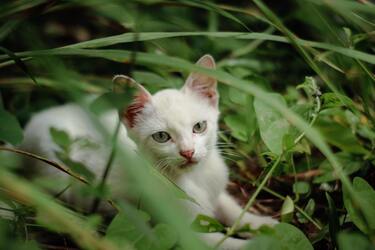Scientists explain why cats constantly land on their paws

Scientists are well aware of cases of cats falling from great heights. Surprisingly, they often do not break and receive only minor injuries or, in some cases, do without them at all.
This phenomenon has been a subject of interest for scientists for many years, which were trying to understand how pets have such an amazing ability to survive rthe falls.
Read also: Why cats like to lie down on their owners' feet: an explanation
However, the biggest mystery was the fact that cats are always able to land on their paws, avoiding serious damage during a fall, Scientific American writes.
How do cats land on their paws?
As soon as scientists managed to solve this mystery in 1969, it was called the "falling cat problem". It turned out that during a fall, the upper and lower parts of the animal's body rotate in opposite directions, which allows it to comply with the law of conservation of momentum. This unique behavior allows cats to turn over in the air and land safely on their paws.
This is due to the laws of classical mechanics, which cats use with amazing agility. When a cat approaches the ground, it squeezes its front paws toward its body, thereby reducing the moment of inertia. Similarly to figure skaters, the cat's upper body rotates rapidly around its axis. At the same time, the hind legs create the opposite effect, stretching out to increase the moment of inertia. A flexible spine plays a key role in performing such maneuvers.
Read also: Scientists answered why cats do "massage" with their paws to their owners
When the upper body is in the correct position, the head is above the ground and the animal stretches its front and back legs to land on them. Thus, cats always land on four legs without violating physical laws. However, there is one interesting point.
The higher the height from which a cat falls, the softer it lands?
According to the laws of physics, the higher the height from which an object falls, the harder it hits the surface. However, American scientists discovered in the 1980s that this rule does not apply to cats. Studies have shown that animals falling from lower heights sustained more injuries (and sometimes died) than their relatives falling from higher heights. Cats that fell from the 15th floor made a softer landing than those that fell from the 7th floor. At the same time, it seemed that the cats did not follow the laws of physics. But this was not the case.
Read also: Why you should sleep with cats: superstitions and scientific explanations
Scientists explained that although the cat's speed increases at the beginning of the fall due to gravity, they do not take into account the air resistance, which slows down the speed. According to physicist Rhett Alleyne from Southeastern Louisiana University, USA, the cat's speed stops increasing after a certain point due to strong air resistance.
With the help of mathematical formulas, you can even calculate the approximate speed of a cat's fall, given its weight, length and width. For example, with a weight of 4 kg, a length of 50 cm and a width of 15 cm, the final speed of the animal will be about 32 km/s or slightly less than 120 km/h.
According to Alleyne, this is the speed a cat can reach when falling from a height of 100 meters. Based on numerous cases where cats were not seriously injured even after falling from even higher heights, scientists suggest that cats are theoretically able to survive a fall from any height.
Visit the link to learn why you shouldn' t sleep with cats in bed.
If you want to get the latest news about the war and events in Ukraine, subscribe to our Telegram channel!
